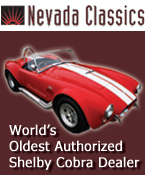 
 Main Menu
Main Menu
|
 Nevada Classics
Nevada Classics
|
 Advertise at CC
Advertise at CC
|
 December 2024
December 2024
|
| S |
M |
T |
W |
T |
F |
S |
| 1 |
2 |
3 |
4 |
5 |
6 |
7 |
| 8 |
9 |
10 |
11 |
12 |
13 |
14 |
| 15 |
16 |
17 |
18 |
19 |
20 |
21 |
| 22 |
23 |
24 |
25 |
26 |
27 |
28 |
| 29 |
30 |
31 |
|
|
|
|
|
 CC Advertisers
CC Advertisers
|
|

12-21-2006, 08:25 AM
|
 |
CC Member

|
|
|
Join Date: Dec 2006
Location: Millbrook,
NY
Cobra Make, Engine: ERA 758 KC Pond 482
Posts: 391
|
|

 Not Ranked
Not Ranked
 Sodium filled valves
Sodium filled valves
Many years ago I had a 427MR that dropped an exhaust valve and broke a piston. Apparently the guy who did the heads used sodium filled valves and not the Manley valves I had specified. I never hear any talk about these valves and am assuming nobody uses them so they don't go through the nasty experience I had.
Anybody using these? They were supposed to be lighter I believe.
|
-
Advertising


12-21-2006, 08:49 AM
|
 |
CC Member

|
|
|
Join Date: May 2006
Cobra Make, Engine: SPF#2189
Posts: 357
|
|

 Not Ranked
Not Ranked
__________________
Steve
Last edited by SJK2; 12-21-2006 at 08:52 AM..
|

12-21-2006, 09:18 AM
|
|
Senior Club Cobra Member

|
|
|
Join Date: Jul 2002
Cobra Make, Engine:
Posts: 15,712
|
|

 Not Ranked
Not Ranked
Seems to me sodium filled valves used to be fairly common 'back in the day' and widely available for lot's of different motors. You don't hear much about them today except for things like 'they break'. I don't know if thats really the case or the valves are just getting a bum rap.
Steve, I checked that link, sure enough it says sodium filled exhaust valves on the new Vette.
|

12-21-2006, 09:36 AM
|
 |
CC Member

|
|
|
Join Date: May 2001
Location: California,
Ca
Cobra Make, Engine: NAF 289 Slabside Early Comp Car with 289 Webers and all the goodies. Cancelling the efforts of several Priuses
Posts: 6,592
|
|

 Not Ranked
Not Ranked
The sodium valves were OEM in the side oiler and were the achillies heel in the valve train. I think the manufacturing processes at the time led to the potential of having the stem fracture at the underside of the valve. The theory is that the sodium helps disipate some of the heat in the valve. Metallurgy marched forward and different alloys of Stainless were used for the valves as was Titanium in some types of racing but the wear on the seat and valve face limits Titaniums usage.
__________________
Rick
As you slide down the Banister of Life, may the splinters never be pointing the wrong way 
Last edited by Rick Parker; 12-21-2006 at 09:39 AM..
|

12-21-2006, 09:42 AM
|
 |
CC Member

|
|
|
Join Date: Aug 2004
Location: SE Wisconsin,
Wi
Cobra Make, Engine: Arntz/SBC/Jag
Posts: 1,033
|
|

 Not Ranked
Not Ranked
VW has been using them on several of their supercharged and turbo motors since the early 90's, and they have been nothing but reliable in those engines.
|

12-21-2006, 10:17 AM
|
 |
Senior Club Cobra Member

|
|
|
Join Date: Oct 2004
Location: Granite Bay,
Ca
Cobra Make, Engine: SPF GT40P-2265/393W, KMP318 (PROJECT!!!!!)/CSX478
Posts: 1,158
|
|

 Not Ranked
Not Ranked
I use them on the exhaust side of my Porsche 912 motors. In fact, just about everyone does. No problems with breakage, and better cooling than stock.
__________________
Ron R
"Dishwasher? I thought that was for cleaning parts!?"
|

12-21-2006, 10:34 AM
|
|
CC Member

|
|
|
Join Date: May 2006
Location: St. Louisville,
Oh
Cobra Make, Engine: A&C 67 427 cobra SB
Posts: 2,445
|
|

 Not Ranked
Not Ranked
I read that Ford did use sodium filled valves on the 427 back in the day (think only on the exhaust). They reportedly did it to be able to run higher RPM via the lighter valves (other benifits may apply). Heads breaking off of these valves were very common. Drag racers of the day had different opinions. Some quit using them others replaced then after a few runs.
Better material and manufacturing practises may exist today. Maybe the old problems have been solved. However these are relatively large diameter valves, mind you. Just because a Porsche can run them without issues, does not necessarily mean they will work on a relatively monster sized valve in a big block.
Unless you are building a high rpm FE, they likely are not needed. Sounds like a risky path to me.
|

12-21-2006, 11:21 AM
|
 |
CC Member

|
|
|
Join Date: Jun 2003
Location: Freedomia,,
Il
Cobra Make, Engine: Coupe,Blue w/white stripes SB; Roadster, Blue w/white stripes BB w/2-4s; SPF installer/Hot Rod-Custom Car builder
Posts: 1,376
|
|

 Not Ranked
Not Ranked
They were used for many years on VW van engines, I still have several new ones left over. My understanding regarding the 427 valves was that they would pop the head if they weren't warmed up to temp prior to hammering them. The sodium turns to liquid under heat and the sloshing aided in cooling of the head. I never used them because of the extra expense and the spotty record. The ones in the VWs never encountered a problem like that, although VW valves in general will pop heads after extended use in an engine from stem heat fatigue crystalizing the grain structure. I think the lightweight, head diameter in relation to the stem, plus lower revs made them less of a problem than the 427s were.
__________________
WDZ
|

12-21-2006, 01:41 PM
|
 |
CC Member

|
|
|
Join Date: May 2002
Location: Syracuse,
NY
Cobra Make, Engine: Contemporary classics 3041,sbc 350(have no fear ford guys for there is a FE 428 in the garage waiting to be rebuilt & installed) but for now she is a driver while other projects take precidence.
Posts: 405
|
|

 Not Ranked
Not Ranked

I have gmpp aluminum "fast Burn" heads on my 390 stroker sbc, this passage is taken gmpp's site........
Quote:
D shaped 78cc exhaust port and runners provide exceptional flow for applications well in excess of 500 horsepower.
Raised runner (.240 higher than conventional 23° head) intake ports with 210cc ports and runners provide exceptional flow for applications well in excess of 500 horsepower. Raising the top of the intake ports provides a better “line-of-sight” through the port and onto the back side of the intake valves.
The 62cc fast burn combustion chambers are the most efficient combustion chambers ever to be incorporated on a GM Performance Parts cylinder head. Their Fast Burn efficiency produces higher cylinder pressures by burning more of the available fuel before the piston starts its power stroke downward. Additionally, by more completely using the available fuel, the head ensures that an engine is producing more power for a given quantity of fuel.
The Fast Burn head’s specially designed valve seats will accommodate up to 2.02 intake valves and 1.600 exhaust valves. Their design also provides superior structural characteristics.
The 2.00 hollow stem lightweight intake valves are utilized to provide exceptional flow and intake charge velocity. Their light weight makes them suitable for sustained high RPM applications as well as reducing loads on valve springs, rocker arms, push rods, roller lifters and camshaft.
The 1.56” sodium filled lightweight exhaust valves have all the same great benefits of the hollow stem intake valves. In addition, they are able to perform in extremely high-temperature performance applications.
|
Interesting that they only use the sodium filled stems on the exhaust. I have not broken one yet, and they really rev.
Dan
__________________
THOUGHT FOR THE DAY: There is more money being spent on breast implants and Viagra than on Alzheimer's research. This means that by 2030, there should be a large elderly population with perky boobs and huge erections and absolutely no recollection of what to do with them.
|

12-26-2006, 05:46 PM
|
|
CC Member

|
|
|
Join Date: Dec 2000
Location: Avondale,
Pa
Cobra Make, Engine: Contemporary, Shelby Alum 427, Dove heads
Posts: 55
|
|

 Not Ranked
Not Ranked
It was my understanding that there was only a problem when using high lift cams, over .600 lift, because of the hard return. They are much lighter.
__________________
In school 90% is exceptional, in life 10% wrong is failure.
|

12-26-2006, 07:13 PM
|
 |
CC Member

|
|
|
Join Date: Jun 2003
Location: Freedomia,,
Il
Cobra Make, Engine: Coupe,Blue w/white stripes SB; Roadster, Blue w/white stripes BB w/2-4s; SPF installer/Hot Rod-Custom Car builder
Posts: 1,376
|
|

 Not Ranked
Not Ranked
Quote:
|
Originally Posted by avanti-176
I have gmpp aluminum "fast Burn" heads on my 390 stroker sbc, this passage is taken gmpp's site........
Interesting that they only use the sodium filled stems on the exhaust. I have not broken one yet, and they really rev.
Dan
|
I think the exhaust are usually all that get the sodium treatment, since they only flow hot gases they benefit most. I think that the 427 ones were just the exhausts, although I'm not positive. They were used on the FT exhausts and the exhaust was the only valve that VW used them on. The FT and the VW also had bigger diameter valve stems, which would reduce flow, but the 427 ones had standard stem diameter. That may have also lead to some of the failures. I don't recall seeing either the VW or the FT valves ever "popping" as would happen with the 427 ones.
__________________
WDZ
|

12-26-2006, 08:31 PM
|
 |
Senior Club Cobra Member

|
|
|
Join Date: Mar 2001
Location: Southern Connecticut,
CT
Cobra Make, Engine: SPF - 351W, 944 non-turbo
Posts: 2,105
|
|

 Not Ranked
Not Ranked
No need to use them on intake valves since they are against the head when the fire is burning. When they open a cool intake charge comes by. The exhaust valve, on the other hand, gets a very hot flame all around it 25 times per second at 3,000 RPM. The longer the duration the less time it has to cool against its seat. It's a tough life being an exhaust valve.
Bob
|

12-28-2006, 12:38 AM
|
|
CC Member

|
|
|
Join Date: May 2002
Location: San Francisco CA,
Posts: 525
|
|

 Not Ranked
Not Ranked
 There is nothing wrong with NEW sodium filled valves...
There is nothing wrong with NEW sodium filled valves...
Sodium filled exhaust valves are used in nearly every air-cooled engine, especially air-cooled aircraft engines.
The main design use is to dissapate heat, not really for light weight.
That's why they are so important in air-cooled engines.
The problem with sodium filled valves is the sodium creates corrosion inside the valve stem.
Sodium (salt) corrodes metal. The older the valve, the more the corrosion, new or used.
It was common practice to replace the exhaust valves after every race on the Ford NASCAR teams 427s and Boss 429s.
Forty + year old OEM Ford valves, wether they are used or NOS, are ticking time bombs in your engine.
We used to X-ray the sodium filled valve stems to be sure they were ok to use. I found so many that were paper thin that I decided never to trust old valves, NOS or not.
I stick with stainless steel on the street and titanium on the track.
HTH,
--Mike
__________________
They bend 'em, we mend 'em.
|

12-28-2006, 05:10 AM
|
 |
CC Member

|
|
|
Join Date: Dec 2004
Location: Prince Frederick,
MD
Cobra Make, Engine: Unique 427 S/C 427 FE S.O. 484 cu in
Posts: 952
|
|

 Not Ranked
Not Ranked
Quote:
|
Originally Posted by SFfiredog
Sodium filled exhaust valves are used in nearly every air-cooled engine, especially air-cooled aircraft engines.
The main design use is to dissapate heat, not really for light weight.
That's why they are so important in air-cooled engines.
The problem with sodium filled valves is the sodium creates corrosion inside the valve stem.
Sodium (salt) corrodes metal. The older the valve, the more the corrosion, new or used.
It was common practice to replace the exhaust valves after every race on the Ford NASCAR teams 427s and Boss 429s.
Forty + year old OEM Ford valves, wether they are used or NOS, are ticking time bombs in your engine.
We used to X-ray the sodium filled valve stems to be sure they were ok to use. I found so many that were paper thin that I decided never to trust old valves, NOS or not.
I stick with stainless steel on the street and titanium on the track.
HTH,
--Mike
|
.....ditto...... |
 Posting Rules
Posting Rules
|
You may not post new threads
You may not post replies
You may not post attachments
You may not edit your posts
HTML code is Off
|
|
|
All times are GMT -7. The time now is 11:04 PM.
|





















 Linear Mode
Linear Mode



